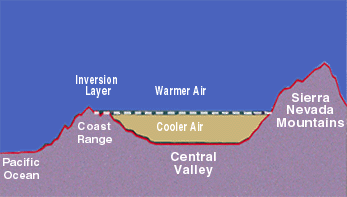|
|
| Inversion Layers | ||

Pollutants are then carried into the mountains on upslope winds on an
almost daily basis during the summer months. In the winter when the sun
angle is lower in the sky, inversions are stronger and longer lasting.
It isn't until a low pressure system moves in with wind and rain that
the stagnant air clears out, lifting the veil of pollution away from the
valley and mountain slopes. Rain and snowfall can clear the air, but they
can also carry pollutants in the form of nitric and sulfuric acid, dropping
them into lakes, rivers, and soil. Hence, air pollution affects not only
the air we breathe, but many terrestrial and aquatic environments as well.
|
||
|
© 2006 SJVAPCD. All Rights Reserved. |